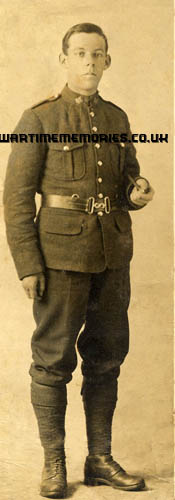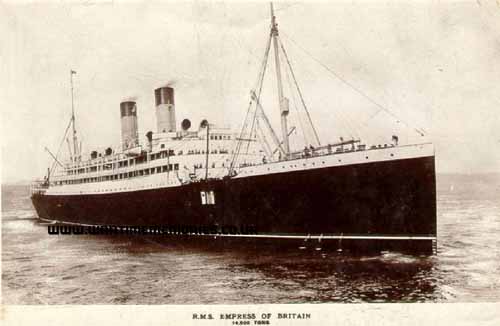Additions will be checked before being published on the website and where possible will be forwarded to the person who submitted the original entries. Your contact details will not be forwarded, but they can send a reply via this messaging system.
please scroll down to send a message
Pte. Ronald William Bellew
Canadian Expeditionary Force 14th Battalion Royal Montreal Regiment
from:Kilronan, Saskatchewan
(d.26th September 1916)
Ronald Bellew was born on the 30th April 1894 at Whitechapel Cottage, Bish Mill, Bishops Nympton, North Devonshire. Ronald was the eldest son of Charles Bellew (born 14th March 1874, Horwood), and Rebecca Ann (Annie) Bellew, nee Westcott, (born 5th December 1873, baptised 12th July 1874, Mariansleigh). Ronald was the brother of Michael, Prudence, Annie (mother of Angela Bavidge, nee Kingdon), Barbara, Rosina, George and Albert Bellew.
Ronald's parents left Bishops Nympton in the late 1890s when his father found work at Meshaw, a few miles from Bishops Nympton. The family was living at Prescott Cottage, Meshaw in 1901. Ronald attended Meshaw School and is mentioned several times in the School's log book. On the 16th July 1909 there is an entry in the school log showing that Annie, Rosie, and Prudence Bellew are leaving school on account of changing farms. Michael had already left school on the 26th March 1909 to work. Ronald being the eldest must have left school before that. In 1911 Ronald, age 16, is working as a cowman for John Hancock, farmer at Rawstone Farm, Bishops Nympton. The family returned to the Bishops Nympton area and lived at Folly Cottage where Ronald's two younger brothers, George and Albert were born in 1912 and 1915 respectively.
Maud Harland (nee Westcott), Ronald's mother's sister, left England to homestead in Canada, with her husband Norman in 1910. Ronald was close to his aunt and decided to emigrate to Canada. Ronald left Liverpool for Halifax, Nova Scotia on the SS Mongolian on the 25th April 1913 to homestead in Canada. He completed an application for entry for a Homestead on the 16th April 1914. His address was shown as Kilronan, Charlotte, Saskatchewan. He occupied his homestead from the 20th November 1914 until the 12th April 1915. Both Ronald's and his Aunt Maud's homesteads were in the Battleford area, Saskatchewan.
When the German-European War broke out, Ronald enlisted with the Canadian Overseas Expeditionary Force at Battleford, Saskatchewan on the 24th April 1915, with the 53rd Battalion. His Army documents, describe him as having a dark complexion, hazel eyes, dark brown hair and a scar on the right corner of mouth. He was 5 feet 8 inches tall and weighed 145lbs. Religious denomination was Church of England. His pay was $30 per month, plus a field allowance of 20 cents per day. His medical record shows that he was in hospital with diphtheria on 2nd March 1916.
On the 29th March 1916 he sailed from Halifax, Canada on the S.S Empress of Britain, and disembarked at Liverpool, England on the 9th April 1916. He was in England from the 9th April 1916 until he embarked for France on the 8th June 1916. He arrived at Le Havre on the 9th June 1916. He was admitted to the General Hospital in Le Havre on 10th June 1916 and was discharged on 22nd June 1916 On the 14th July 1916 he was taken on strength of the 14th Battalion of the Royal Montreal Regiment. He joined his Unit on 11th August 1916.
He was killed in action on the 26th of September 1916 at Kenora Trench, near Courcellette, Battle of the Somme. On the 5th April 1917 it was recorded that Ronald was presumed to have died, on or since, the 26th September 1916. The Canadian Record Office, Green Arbour House, Old Bailey, London, sent a letter to Charles and Rebecca dated 4th April 1917 "It is my painful duty to inform you that owing to the lapse of time and to the fact that no information has come to hand from any source whatever indicating that this soldier might still be alive, the Militia Council have been regretfully constrained to conclude that he is dead."
His medals, decorations and Memorial Cross were sent to his mother, Annie Bellew. Plaque and scroll, serial number 76421, were sent to his father Charles Bellew, on the 27th May 1920. Charles and Rebecca were living at Folly Cottage, South Molton, Devon, England.
Ronald's name appears on the Vimy Memorial, which overlooks the Douai Plain from the highest point of Vimy Ridge, about eight kilometres northeast of Arras on the N17 towards Lens. The names of 11,285 Canadian Soldiers, who have no known grave, are listed.
Canada was a Dominion of Great Britain without any International standing and when Britain declared War on Germany in August 1914, Canada was automatically at war. In 1914 Canada's population was just under 8 million. The Canadian government issued tens of thousands of posters as a way to encourage voluntary enlistment, bearing in mind that there were no radios or TVs at that time. The Military Service Act of August 1917 introduced conscription. Most French-speaking Canadians did not support Canada's overseas military commitments to the same degree as English speakers. Two-thirds of the men of the first contingent had been born in the British Isles. Most had settled in Canada in the 15-year period of massive immigration which had taken place before the start of WW1. By the end of the war Canada had suffered over 66,000 killed and over 170,000 wounded, roughly a 35% casualty rate. This was the highest of any of the Dominions. The Canadians fought and died in numerous battles from 1915 through to 1918 for example, Neuve Chapelle, Ypres, The Somme, Vimy Ridge and Passchendaele


